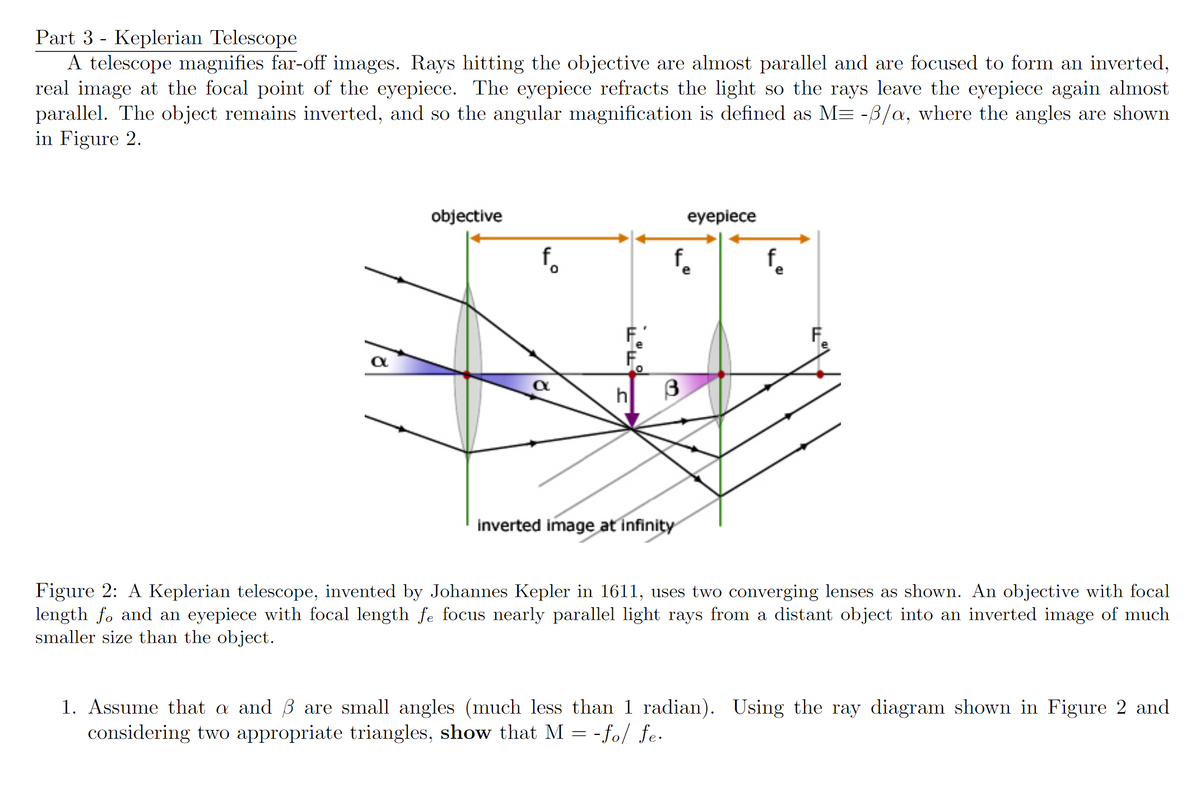Part 3 - Keplerian Telescope A telescope magnifies far-off images. Rays hitting the objective are almost parallel and are focused to form an inverted, real image at the focal point of the eyepiece. The eyepiece refracts the light so the rays leave the eyepiece again almost parallel. The object remains inverted, and so the angular magnification is defined as M= -3/a, where the angles are shown in Figure 2. objective eyepiece f. fe h inverted image at´înfinity Figure 2: A Keplerian telescope, invented by Johannes Kepler in 1611, uses two converging lenses as shown. An objective with focal length fo and an eyepiece with focal length fe focus nearly parallel light rays from a distant object into an inverted image of much smaller size than the object. 1. Assume that a and B are small angles (much less than 1 radian). Using the ray diagram shown in Figure 2 and considering two appropriate triangles, show that M = -fo/ fe.
Part 3 - Keplerian Telescope A telescope magnifies far-off images. Rays hitting the objective are almost parallel and are focused to form an inverted, real image at the focal point of the eyepiece. The eyepiece refracts the light so the rays leave the eyepiece again almost parallel. The object remains inverted, and so the angular magnification is defined as M= -3/a, where the angles are shown in Figure 2. objective eyepiece f. fe h inverted image at´înfinity Figure 2: A Keplerian telescope, invented by Johannes Kepler in 1611, uses two converging lenses as shown. An objective with focal length fo and an eyepiece with focal length fe focus nearly parallel light rays from a distant object into an inverted image of much smaller size than the object. 1. Assume that a and B are small angles (much less than 1 radian). Using the ray diagram shown in Figure 2 and considering two appropriate triangles, show that M = -fo/ fe.
Related questions
Question

Transcribed Image Text:Part 3 - Keplerian Telescope
A telescope magnifies far-off images. Rays hitting the objective are almost parallel and are focused to form an inverted,
real image at the focal point of the eyepiece. The eyepiece refracts the light so the rays leave the eyepiece again almost
parallel. The object remains inverted, and so the angular magnification is defined as M= -B/a, where the angles are shown
in Figure 2.
objective
eyepiece
f.
f.
f.
F
e
F.
h
inverted image at infinity
Figure 2: A Keplerian telescope, invented by Johannes Kepler in 1611, uses two converging lenses as shown. An objective with focal
length fo and an eyepiece with focal length fe focus nearly parallel light rays from a distant object into an inverted image of much
smaller size than the object.
1. Assume that a and ß are small angles (much less than 1 radian). Using the ray diagram shown in Figure 2 and
considering two appropriate triangles, show that M = -fo/ fe.
Expert Solution
This question has been solved!
Explore an expertly crafted, step-by-step solution for a thorough understanding of key concepts.
Step by step
Solved in 5 steps with 2 images
